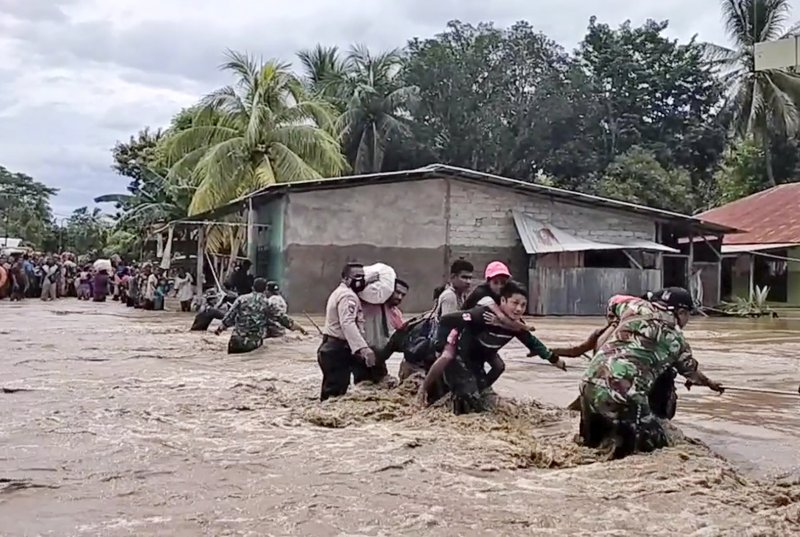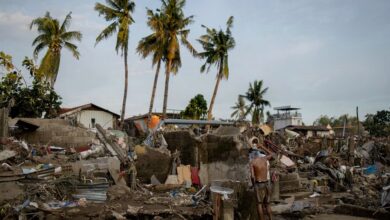
LEMBATA, Indonesia (AP) — Rescuers were hampered by damaged bridges and roads and a lack of heavy equipment Monday after torrential rains caused multiple disasters on remote eastern Indonesian islands as well as East Timor.
At least 55 people have died and more than 40 are missing in Indonesia, and 11 deaths were reported in East Timor. The tropical cyclone causing the damage is expected to continue affecting the Southeast Asian nations for days while moving south toward Australia.
Mud tumbled down from surrounding hills onto dozens of homes in Lamenele village shortly after midnight Sunday on Adonara island in East Nusa Tenggara province. Rescuers recovered 38 bodies and at least five people were injured, said Lenny Ola, who heads the local disaster agency.
Flash flooding killed at least 17 people elsewhere and at least 42 are missing, according to the National Disaster Mitigation Agency.
Relief efforts were hampered by power outages, blocked roads covered in thick mud and debris, as well as the remoteness of the area on an island that only can be reached by sea which is now surrounded by high waves, said the agency’s spokesperson, Raditya Jati.
Photos released by the agency showed rescuers and police and military personnel taking residents to shelters.
The bodies of three people were recovered after being swept away by floods in Oyang Barang village, where 40 houses were also destroyed, Ola said. Hundreds of people fled submerged homes, some of which were carried off by the floodwaters.
In another village, Waiburak, three people were killed and seven missing after overnight rains caused rivers to burst their banks, sending muddy water into large areas of East Flores district, Ola said. Four injured people were being treated at a local health clinic.
The rains also caused cold lava to tumble down the slopes of Ili Lewotolok volcano and hit several villages. That disaster on Lembata island killed at least 11, while at least 16 others were still buried under tons of cold lava, Jati said. The lava was left after the volcano had erupted in November.
Hundreds of people were still involved in the rescue efforts as of Monday. At least nine villages have been affected by flash floods and a landslide that cut five bridges on the island, he said.
President Joko Widodo said he had ordered his cabinet ministers and the chiefs of the military, police and disaster agency to carry out emergency response measures and search and rescue operations as quickly as possible.
“I can feel the grief of our brothers and sisters there caused by this disasters,” Widodo told a televised address, offering his deep condolences to the victims.
In East Timor, 11 people were killed in the capital, Dili, as the rains caused flooding, overflowing dams and landslides. “We are still searching for the areas impacted by the natural disasters” and the toll could rise, said Joaquim José Gusmão dos Reis Martins, the nation’s secretary of state for civil protection.
Tropical Cyclone Seroja has produced high waves, strong winds and heavy rains for the past three days and its effects were expected to last until Friday, said Dwikorita Karnawati, the head of Indonesia’s Meteorology, Climatology, and Geophysical Agency.
She warned that the cyclone could trigger tidal waves up to 4 meters (more than 13 feet) on Sumba, Flores and Rote islands in East Nusa Tenggara province and up to 6 meters (19.6 feet) in the southern part of the province and in the Banda Sea and Indian Ocean.
Authorities were still collecting information about the full scale of casualties and damage in the affected areas, Jati said. Severe flooding also has been reported in Bima, a town in the neighboring province of West Nusa Tenggara, forcing more than 10,000 people to flee.
Seasonal rains frequently cause flooding and landslides in Indonesia, an archipelago of 17,000 islands where millions of people live in mountainous areas or near fertile flood plains.
Australian forecasters have warned residents in Western Australia state’s far north that the tropical cyclone was intensifying and moving toward them.
Seroja, or lotus flower, formed early Monday morning in Indonesian waters and was moving southwest, Australia’s Bureau of Meteorology said. It’s not expected to affect Australian communities for the next 48 hours, but residents were urged to monitor forecasts.
_____
Karmini reported from Jakarta, Indonesia. AP journalist Raimundos Oki in Dili, East Timor, contributed to this report.




